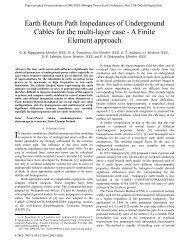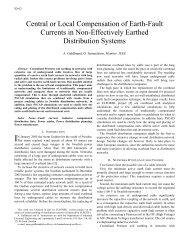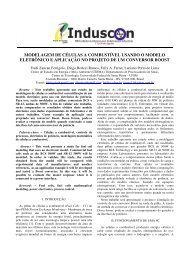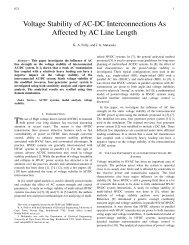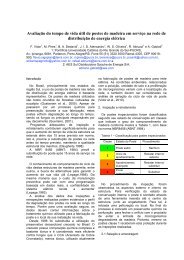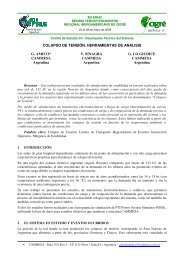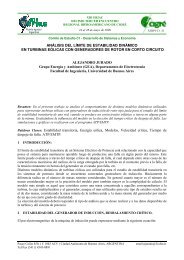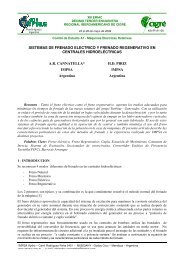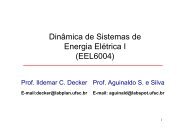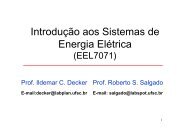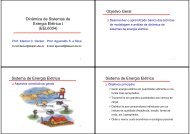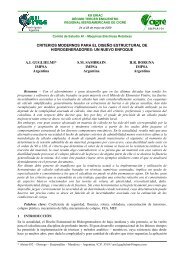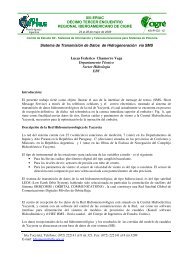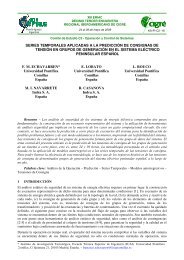A NEUTRAL POINT CLAMPED MULTILEVEL RECTIFIER ... - LabPlan
A NEUTRAL POINT CLAMPED MULTILEVEL RECTIFIER ... - LabPlan
A NEUTRAL POINT CLAMPED MULTILEVEL RECTIFIER ... - LabPlan
You also want an ePaper? Increase the reach of your titles
YUMPU automatically turns print PDFs into web optimized ePapers that Google loves.
XVIII Congresso Brasileiro de Automática / 12 a 16-setembro-2010, Bonito-MS<br />
A <strong>NEUTRAL</strong> <strong>POINT</strong> <strong>CLAMPED</strong> <strong>MULTILEVEL</strong> <strong>RECTIFIER</strong> FOR GRID CONNECTED WIND<br />
ENERGY SYSTEM<br />
FRANCISCA L. C. PIRES, FERNANDO L. M. ANTUNES, DEMERCIL S. OLIVEIRA JR.<br />
Grupo de Processamento de Energia e Controle, Depto. de Engenharia Elétrica, Universidade Federal do<br />
Ceará<br />
Caixa Postal 6001, 60455-760, Campus do Pici, Fortaleza, CE, Brasil<br />
E-mails: francisca_livia@yahoo.com.br, fantunes@dee.ufc.br,<br />
demercil@dee.ufc.br<br />
Abstract⎯ In this paper a neutral point clamped converter is used as a machine side converter in a wind energy conversion system.<br />
This converter was used as a rectifier. For the rectifier operation was developed a maximum power point tracker control, without<br />
speed sensors, associated to a power factor control, using a one cycle control technique. Simulation results are presented to access the<br />
performance of the NPC rectifier along with the PFC and MPPT strategies.<br />
Keywords⎯ Rectifier, neutral point clamped, wind energy system, one cycle control, maximum power point tracking.<br />
Resumo⎯ Neste artigo um conversor do tipo neutral point clamped é utilizado como conversor no lado da máquina em um sistema<br />
de conversão de energia eólica. Este conversor foi implementado como um retificador. Para a operação do retificador foi desenvolvido<br />
um controle rastreador do ponto de máxima potência, sem a necessidade de sensores de velocidade, associado a um controle de correção<br />
de fator de potência utilizando a técnica de controle de um ciclo. Resultados de simulação são apresentados para comprovar o desempenho<br />
do retificador NPC com as estratégias de PFC e MPPT escolhidas.<br />
Palavras-chave⎯ Retificador, ponto neutro grampeado, sistema de energia eólica, controle de um ciclo, seguidor de máxima potência.<br />
1 Introduction<br />
The development of renewable energy sources<br />
has attracted considerable interest in recent years.<br />
Several techniques have been used for connecting<br />
these sources to the electrical grid.<br />
Currently, obtaining electricity from the wind offers<br />
the cheapest economic perspectives of renewable<br />
energy sources. Wind generators integrated with<br />
power electronic interfaces are becoming popular<br />
due to their capability of extracting optimal energy<br />
capture (Raju et. al., 2003).<br />
The wind conversion systems could use fixed or variable<br />
speed turbines and different kinds of generators<br />
(squirrel cage induction, wound rotor induction,<br />
doubly-fed induction and permanent magnet synchronous<br />
generator). Also could present several converter<br />
topologies and different ways of doing the<br />
interconnection, depending on generator and turbine<br />
types (Blaabjerg et. al., 2007).<br />
For allowing the interconnection many control techniques<br />
for the AC/AC converters are applied. Basically<br />
it is necessary a rectifier with a power factor<br />
correction capability using a PLL or another method<br />
of control and a maximum power point tracker<br />
(MPPT) to allow the maximum power extraction<br />
from the turbines, a DC link which voltage can be<br />
controlled by the rectifier or the inverter, a DC-AC<br />
converter with the control of active and reactive<br />
power injected in the grid.<br />
1583<br />
Multilevel converters have become popular in the<br />
last years due to advantages at medium and high<br />
voltage applications. Three-level converters are the<br />
most popular because of their simplicity and efficiency.<br />
Advantages of multilevel converters include good<br />
power quality, good electromagnetic compatibility<br />
(EMC), low switching losses, and high voltage capability.<br />
The main disadvantages of this topology<br />
are that a larger number of semiconductor switches<br />
are required and the voltage on the DC side must be<br />
supplied by a capacitor bank with several capacitors<br />
or by several isolated voltage sources (Corzine,<br />
2003).<br />
This paper presents a three-level neutral point<br />
clamped converter (NPC) in a back-to-back conversion<br />
system for wind generators connected to the<br />
grid. The NPC converter was designed to operate as<br />
the machine side converter. For efficient operation is<br />
required for the converter a power factor control<br />
(PFC) and a MPPT.<br />
For extracting the optimum power from the wind, a<br />
simple MPPT strategy is used without the knowledge<br />
of the turbine parameters (Reis et. al., 2007).<br />
The power factor correction uses the principle of on<br />
one-cycle control with a simple sine-triangle modulation<br />
(Bento, 2009). Simulation results are presented<br />
to access the performance of the NPC rectifier<br />
along with the PFC and MPPT strategies.
XVIII Congresso Brasileiro de Automática / 12 a 16-setembro-2010, Bonito-MS<br />
2 Wind Energy Conversion System<br />
The configuration chosen for interconnection<br />
with the grid is shown on Figure 1. This configuration<br />
corresponds to a generator directly connected to<br />
the grid through a back-to-back AC/AC converter<br />
(Blaabjerg et. al., 2007). In this concept the generator<br />
is completely decoupled from the grid (Pereira,<br />
2008). The energy from the generator is rectified to<br />
a DC link, and then it is converted to a suitable AC<br />
energy for the grid (Carrasco et. al., 2006).<br />
Figure 1. Wind energy system chosen<br />
Each component showed in Figure 1 has its main<br />
characteristics as following described (Blaabjerg et.<br />
al., 2007e Carrasco et. al., 2006):<br />
• Wind turbine capture power from the wind<br />
and convert it to rotating mechanical power.<br />
• The gear box can be used to convert the<br />
low-speed, high-torque power to electrical<br />
power, but it is not necessarily used.<br />
• The generator can be a wound rotor synchronous<br />
generator or a permanent magnet<br />
synchronous generator.<br />
• A multilevel power converter topology is<br />
used to connect the stator windings to the<br />
grid. For this system was considered a Neutral<br />
Point Clamped (NPC) topology, which<br />
presents a voltage with three levels.<br />
The AC-AC converter is shown on Figure 2, in<br />
which two NPC converters form the back-to-back<br />
system, connected through a DC-link using two capacitor<br />
banks with the same voltage. In this work is<br />
described only the AC-DC side and its control methods<br />
for this application. The control for the inverter<br />
side was not implemented. For this application, it<br />
has been considered a permanent magnet synchronous<br />
generator with a rated power of 6kW.<br />
3 Multilevel Power Converter<br />
In order to decrease the cost per MW and to increase<br />
the efficiency of wind energy conversion, nominal<br />
power of wind turbines has been continuously<br />
growing in last years (Carrasco et. al., 2006). So the<br />
interest for multilevel converters implemented in<br />
wind energy systems has been growing. This occurs<br />
because of the low voltage stress across the switches.<br />
1584<br />
Therefore, multilevel converters are very useful in<br />
medium and high voltage systems.<br />
Figure 2. NPC in a back-to-back conversion system.<br />
The different proposed multilevel converter topologies<br />
can be classified in the following five categories,<br />
shown in Figure 3 (Blaabjerg et. al., 2007):<br />
• Diode clamped;<br />
• Bi-directional switch interconnection;<br />
• Flying capacitors;<br />
• Multiple three-phase converters;<br />
• Cascaded single phase H-bridge converters.<br />
Figure 3. Multilevel topologies: a) one leg of a three-level diode<br />
clamped converter; b) one leg of a three-level converter with bidirectional<br />
switch interconnection; c) one leg of a three-level flying capacitor<br />
converter; d) three-level converter using three two-level converters<br />
and e) one leg of a three-level H-bridge cascaded converter.<br />
As the ratings of the components increases and the<br />
switching and conducting properties improve, the<br />
advantages of applying multilevel converters become<br />
more and more evident. The reduced content of<br />
harmonics in the input and output voltage is highlighted,<br />
together with the reduced EMI. Moreover,<br />
the multilevel converters have the lowest demands<br />
for the input filters or alternatively reduced number<br />
of switching. For the same harmonic performance as<br />
a two level converter, the switching frequency of a<br />
multilevel converter can be reduced to 25% that results<br />
in the reduction of the switching losses. Even<br />
though the conducting losses are higher in the multilevel<br />
converter, the overall efficiency depends on the<br />
ratio between the switching and the conducting<br />
losses (Carrasco et. al., 2006).<br />
4 Diode Clamped Converter<br />
One of the multilevel structures that is widely<br />
used is the Diode clamped converter, presented on<br />
Figure 3(a) An n-level Diode Clamped Converter<br />
consists of (n-1) capacitors on the DC bus, 2(n-1)<br />
switching devices per phase and 2(n-2) clamping<br />
diodes per phase. The DC bus voltage is split into n<br />
levels by using (n-1) DC capacitors. Each capacitor
XVIII Congresso Brasileiro de Automática / 12 a 16-setembro-2010, Bonito-MS<br />
has Vdc/n volts and each voltage stress will be limited<br />
to one capacitor level through clamping diodes.<br />
Figure 4 show a three-level diode clamped converter.<br />
The diode clamped converter has the following advantages<br />
(Pereira, 2008):<br />
• The switch must support a voltage of only<br />
Vdc/(n-1) for a n-levels converter;<br />
• The number of capacitors in DC-link is<br />
smaller than in others multilevel topologies;<br />
• In most cases it is not necessary a transformer;<br />
• Switching losses and interferences are lower<br />
than in two level converters.<br />
While the disadvantages are (Pereira, 2008):<br />
• Clamped diodes must be fast recovery and<br />
support the rated current of the converter;<br />
• Above three-levels, clamped diodes don´t<br />
support the same voltage levels. Therefore,<br />
are used series association of diodes that increase<br />
the number of diodes;<br />
• The voltage on the capacitors must be balanced,<br />
that causes an additional problem to<br />
the control.<br />
5 Neutral Point Clamped Converter<br />
The topology chosen was the three-level diode<br />
clamped converter also known as Neutral Point<br />
Clamped converter or NPC converter. This structure<br />
was first proposed by Nabae et. al. in 1980. Figure 4<br />
shows this topology. The NPC topology is shown on<br />
Figure 4.<br />
The DC bus voltage is split into 3 levels by using 2<br />
DC capacitors, C1 and C2. Each capacitor has Vdc/2<br />
volts and each voltage stress will be limited to one<br />
capacitor level through clamping diodes. The phase<br />
voltage, VAN has three states as given in Table 1<br />
(Mailah et. al., 2009). However, the line voltage VAB<br />
presents five-level voltage.<br />
The mainly advantage for the NPC converter is the<br />
reduced number of levels and semiconductors for a<br />
good performance and low levels EMI and THD.<br />
Figure 4. Neutral Point Clamped topology.<br />
This paper describes a NPC converter operating as a<br />
rectifier for a back-to-back system. For this application<br />
was developed a maximum power point tracker<br />
1585<br />
and a power factor control described at the next sections.<br />
Table 1 - Three-level NPC converter voltage levels and their switching<br />
states for phase A<br />
Voltage Level (VAN) Switches ON<br />
-Vdc/2 Sa3, Sa4<br />
0 Sa2, Sa3<br />
Vdc/2 Sa1, Sa2<br />
6 Maximum Power Point Tracker<br />
Variations of wind on the turbine cause different<br />
values of power generated. When this power is low<br />
some technique must be used to take advantage of<br />
the maximum power extracted from the turbine.<br />
This can be done measuring the rotational speed of<br />
the turbine and adjusting a reference signal or measuring<br />
the output rectifier power, without need<br />
knowing any parameter of the turbine.<br />
The method chosen for the MPPT uses the principle<br />
of perturbation and observation. The dc-link voltage<br />
Vdc is considered constant. The output average current<br />
Idc is measured and the power Pdc is compared<br />
with the previous value, so a reference amplitude<br />
signal (Vm) is changed. This signal Vm is used to<br />
correct the switching pulses of the rectifier.<br />
Figure 5 shows the MPPT control program flowchart<br />
used (Reis et. al., 2007).<br />
Figure 5. – MPPT control program.<br />
The input current in each phase, IA, IB, and IC are<br />
measured and compared to the variable carriers.<br />
This MPPT calculates the output power of the generator<br />
by measuring DC link current and then perturbs<br />
the operating point by increasing/decreasing<br />
the reference Vm shown on Figures 6 and 8.The new<br />
value of power is then compared with the previous
XVIII Congresso Brasileiro de Automática / 12 a 16-setembro-2010, Bonito-MS<br />
value and depending upon the error, Vm magnitude<br />
is further increased or decreased.<br />
7 Power Factor Control<br />
Power factor correction is performed using the<br />
principle of one cycle control (OCC). Figure 6 shows<br />
the schematic of the OCC control for a closed loop<br />
operation (Bento, 2009) in one phase. The variable<br />
Vm, in the output of the voltage regulator, define the<br />
magnitude of the current reference and the shape<br />
current is obtained through a principle of voltage<br />
tracking applied, in a convenient way, to a switching<br />
period.<br />
Figure 6. Schematic of OCC control.<br />
Different from a conventional control with current<br />
loop, this method needs only three sensors for the<br />
three-phase input current and one for the DC output<br />
voltage. There is not current control loop neither<br />
input voltage sensor to form a current reference.<br />
The value of the reference signal Vm on an open loop<br />
operation is defined by:<br />
V<br />
m<br />
R ⋅V<br />
=<br />
2⋅<br />
R<br />
S dc<br />
e<br />
(1)<br />
where Rs represents the sensor gain and Re is the<br />
emulated resistance of the rectifier:<br />
R<br />
e<br />
V<br />
=<br />
I<br />
g<br />
g<br />
(2)<br />
To apply the OCC technique shown on Figure 6 in<br />
NPC rectifier it is necessary three phase reference<br />
currents, measured on the input rectifier that are the<br />
modulators for the Pulse Width Modulation (PWM)<br />
and compare these modulators with variable carriers.<br />
It was chosen the simplest modulation strategy,<br />
SPWM (Sinusoidal Pulse Width Modulation), in<br />
which there is no zero sequence injection and it is<br />
equivalent to connect the load neutral and the source<br />
neutral. Two triangular carriers are necessary: one<br />
positive and other negative. Both are compared with<br />
the measured sinusoidal currents. This SPWM strategy<br />
scheme is shown on Figure 7 (Bento, 2009).<br />
On figure 8, a complete scheme of this strategy is<br />
shown, considering a fixed voltage on DC-link.<br />
Considering a fixed DC voltage, it is not required<br />
the voltage regulator from Figure 6. The reference<br />
1586<br />
sign Vm is controlled by the MPPT control. Two triangular<br />
carriers are obtained using the Vm magnitude.<br />
This carries are compared to three-phase reference<br />
currents measured on rectifier input. As result,<br />
twelve control pulses are obtained.<br />
Figure 7. Basic scheme of SPWM strategy for a NPC.<br />
Figure 8. Complete scheme for SPWM in the NPC rectifier.<br />
8 Simulation Results<br />
The NPC multilevel rectifier was simulated using<br />
the PSIM software, with the parameters of Table<br />
2. In this simulation was considered a fixed output<br />
voltage at the DC-link.<br />
The power generated in a wind system is variable<br />
and depends on the wind. Therefore, simulations<br />
were made considering the rated value of input power<br />
and lower values. To obtain different values of<br />
power were used variances on the three-phase input<br />
voltage.<br />
At simulation the rectifier behavior was observed in<br />
these different values of input voltage and current<br />
for applying the MPPT control.<br />
Table 2 – Considerations for the NPC design<br />
Generator rated power 6 kVA<br />
Generator rated voltage 220 V<br />
Rectifier output voltage 800 V<br />
Rectifier efficiency 0.97<br />
Switching frequency 10 kHz<br />
Input current ripple 1.82 A<br />
Output voltage ripple 20 V
XVIII Congresso Brasileiro de Automática / 12 a 16-setembro-2010, Bonito-MS<br />
For the simulation with rated values, the converter<br />
presented a total harmonic distortion (THD) equal to<br />
3.92% and a power factor equal to 0.9976.<br />
Figure 9 shows the results for rated conditions.<br />
Three-phase current assume the expected peak value<br />
of 12.85 A. Input voltage and current in each phase<br />
presents almost the same angle. The power factor<br />
was calculated for the software and is also showed<br />
on Figure 9.<br />
Figure 10 shows the rectifier output average current<br />
and the input current in one phase after a step on the<br />
input voltage (from 220 to 110V). Without the<br />
MPPT method input current and average output current<br />
decrease to almost a half of their rated values.<br />
Using a MPPT method these currents increase to<br />
values next to the rated ones.<br />
Figure 9. Line currents in a, b and c phases (above) and voltage and<br />
current in one phase (below).<br />
Figure 10. Current of phase A and average output current without<br />
MPPT (above) and with MPPT (below).<br />
9 Conclusion<br />
This paper has presented a multilevel rectifier for<br />
wind generation systems connected to the grid. This<br />
rectifier was simulated with MPPT and PFC control.<br />
The MPPT was implemented only by measuring<br />
turbine output power, without the knowledge of<br />
wind turbine parameters, and the PFC control without<br />
a current loop. The results showed the effectiveness<br />
of the converter topology and control strategy<br />
1587<br />
used. The simulation considered variable voltage<br />
and frequency source, obtaining a maximum extracted<br />
power with a unity power factor and a low<br />
THD value. The laboratory prototype is still under<br />
developed and the experimental results will be obtained<br />
soon to confirm the simulation results.<br />
Acknowledgement<br />
The authors thank to CNPq for the financial support<br />
and incentive to scientific research, the GPEC for<br />
the technical support and all the professors and students<br />
who contributed with this work.<br />
References<br />
Bento, A. A. M (2009). A Técnica de Controle de<br />
um Ciclo Aplicada à Correção do Fator de<br />
Potência com Retificadores Boost. Doctorate<br />
thesis in electrical engineering, Federal<br />
University of Campina Grande.<br />
Blaabjerg, F. and Iov F (2007). Wind Power - a<br />
Power Source Now Enabled by Power<br />
Electronics. 9 th Brazilian Power Electronics<br />
Conference, 2007, Blumenau.<br />
Carrasco, J. M; Galvin, E; Portillo, R; Franquelo, L.<br />
G. and Bialasiewicz, J. T (2006). Power<br />
Electronic Systems for the Grid Integration of<br />
Wind Turbines. IECON 2006 - 32nd Annual<br />
Conference on IEEE Industrial Electronics,<br />
ISSN 1553-572X , pp 4182 – 4188.<br />
Corzine, K (2003). Operation and Design of<br />
Multilevel Inverters. University of Missouri –<br />
Rolla. Developed for the Office of Naval<br />
Research.<br />
Raju, A. B; Fernandes, B. G. and Chatterjee, K<br />
(2003). A Simple Maximum Power Point<br />
Tracker for Grid connected Variable Speed<br />
Wind Energy Conversion System with Reduced<br />
Switch Count Power Converters. Power<br />
Electronics Specialist Conference. PESC '03.<br />
IEEE 34th Annual, Vol. 2, pp. 748-753.<br />
Mailah, N. F; Bashi, S. M; Aris, I; Mariun, N<br />
(2009) Neutral-Point-Clamped Multilevel<br />
Inverter Using Space-Vector Modulation.<br />
European Journal of Scientific Research, ISSN<br />
1450-216X, Vol.28, No.1, 2009, pp.82-91.<br />
Pereira, I. F. B. F (2008). Projectar, Simular e<br />
Implementar um Inversor Multinível. Master’s<br />
degree dissertation in electrical engineering,<br />
University of Porto.<br />
Reis, M. M; Nascimento, R. M.G; Soares, B. L;<br />
Fava, S. A. M; Freitas, E. M; Silva, C. E. A.<br />
and Oliveira, D. S (2007). A Grid Connected<br />
Variable Speed Wind Energy Conversion<br />
System. 9 th Brazilian Power Electronics<br />
Conference, 2007, Blumenau.



